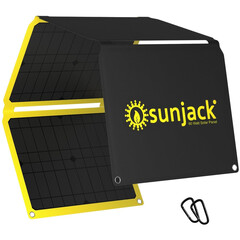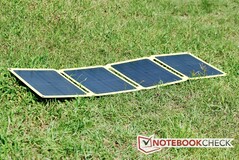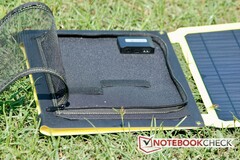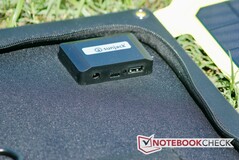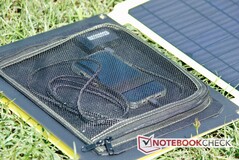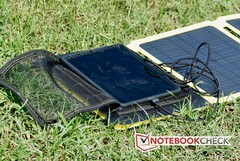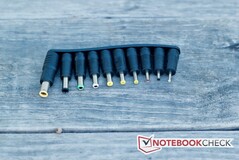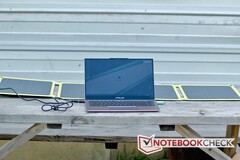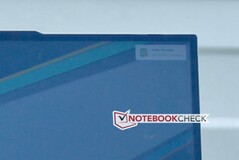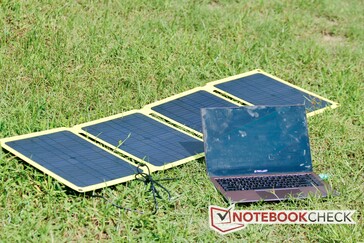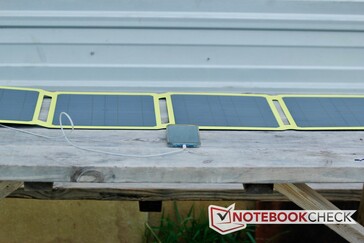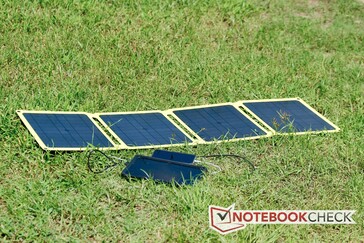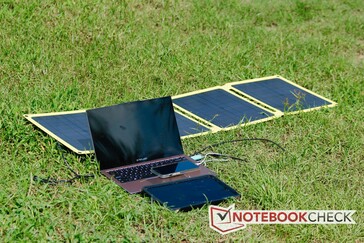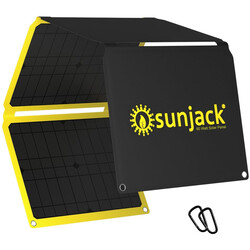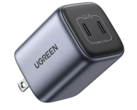Intro
The world is pushing toward renewable, or "green," energy. While huge solar arrays and wind farms are powering more and more urban and suburban areas around the globe, there are some companies focused on powering things smaller than a city, neighborhood, or house. SunJack manufactures small, foldable solar panels for use in rural or remote areas or for those adventurers who want to charge their gadgets in the great outdoors. Their flagship product (as of press time) is a four-panel array that promises up to 60 Watts of power. SunJack sent me one of these to review. Here are my thoughts.
Design and Build Quality
The SunJack panels (listed on their site as the "SunJack 60 Watt Foldable ETFE Monocrystalline Solar Panel Charger") make a solid first impression due to, well, their solid build quality. The panels and their adjacent bezels are covered with an ethylene tetrafluoroethylene (ETFE) plastic. ETFE is a resilient plastic that resists high temperatures and exposure to UV light, which makes it a solid choice for solar panels.
In practice, the Sunjack panels are tough. Even after being tossed onto stone bricks from a height of about 4 feet, the panels show no signs of scratches or cracks. As such, the panels should hold up to rigorous outdoor use. They are also waterproof; water spray beads up and rolls off without ill effect.
The one weakness I noticed in the panels is their extreme rigidity. The individual panels are not flexible, and when I tried to flex one, I heard multiple small cracks. There is no visible damage, and the panel array seems to work without issue, but I wouldn't recommend bending a panel.
The Sunjack panels are designed for portability. To that end, they succeed. The whole array folds into a roughly 37 x 30 cm (14.5 x 11.75 in) footprint. Unfolded, the array measures 118 x 30 cm (46 x 11.5 in). There are grommets on all four corners of the array, and the panels come with two carabiner clips. With these, users can hook the panel array to a backpack and stash their gadgets in their bag to charge on the go. The entire setup weighs 2.2 kg (4.8 lbs).
Speaking of stashing gadgets, the panels have a mesh zipper pouch on the back one of the outside panels. This houses the charging dock and can be used to stow a phone or charging cables. The pouch measures 25 x 29 cm (9.5 x 11.5 inches) and is rather shallow, so a tablet likely won't fit.
The charging dock houses a USB-A port capable of charging at up to 18 Watts, a USB-C port at up to 45 Watts, and a DC output at up to 60 Watts. These ports are easily accessible. Sunjack throws in a DC adapter cable a bevy of tips compatible with several laptop brands. These include:
- 4.0 x 1.7 mm
- 4.8 x 1.65 mm
- 5.5 x 1.7 mm
- 5.5 x 2.5 mm
- 5.5 x 3.0 mm
- 6.0 x 3.0 mm
- 6.5 x 4.4 mm
- 7.4 x 5.0 mm
- 7.7 x 5.5 mm
- 7.9 x 5.5 mm
Features and charging
So the solar panels array is durable, looks good, and has a good selection of charging options. Can it charge anything?
In a word: yes. The panels SunJack sent me are rated at up to 60 Watts of charging, and they deliver... mostly. There's no beating around the bush: solar panels have problems with power efficiency and consistency. Even large solar power plants can have issues providing enough juice to adequately service their area.
The SunJack panels are fairly consistent and were able to charge every device I threw at them, but I'm not sure they can fully deliver 60 Watts. I unfortunately don't have a way to measure exactly how much power they put out. However, I tried the panels with an iPhone 13 (via USB-A and USB-C), an iPad Air 2020 (via USB-A and USB-C), and a Teclast F7 Air laptop (via USB-C and DC).
Let me give some context for my experience with the SunJack solar panels. I live in Central Texas, far out in the country on roughly 3 acres of fairly open land. I laid the solar panels out in my front yard, which is about a half acre of flat grass without any trees in sight. This was on a sunny day without no clouds in the sky in the middle of a dry heat wave (roughly 25% humidity, 43° C or 110° F). This gave the solar panels the best possible chance to operate.
The panels were able to fast-charge my iPhone 13 via both the USB-A and USB-C ports (using authentic Apple cables) at about the same rate as my indoor fast charger, which is an 18-Watt MFi USB-C charger. No problems there.
My iPad Air 2020 ran into some hiccups, however. Both the USB-A and USB-C ports charged the iPad, but at noticeably slow rates. The solar panels seemed to be charging the tablet at somewhere between 5 and 10 Watts; the iPad charged at a little less than half the rate it does with its 20-Watt Apple charger. This could have been due to heat issues; the iPad and the panels were directly in the hot sun. I tested this later on a cloudier, somewhat cooler day (32° or 90° F), but there was no difference. The panels charged the tablet slowly.
The panels charged the Teclast laptop adequately as well. I typically use a 45-Watt USB-C charger with it, and the panels charged the laptop at roughly the same rate via both the USB-C cable and the DC output. However, the panels struggled to consistently charge it; I noticed the laptop would charge for a few minutes and then stop for about a minute before starting the charge again. This cycle continued for the half-hour I had it hooked up to the panels. All said, the panels charged the laptop from 50% to 65% over the half-hour, which is about how fast it normally charges (roughly 1% every 1.5-2 minutes).
Drawbacks
There are some additional drawbacks in addition to the ones mentioned above. The biggest involves charging multiple devices at once. The SunJack panels aren't made for multi-device charging, and plugging in two or three gadgets can cause some issues. For example, I plugged my iPad Air and iPhone 13 into the panels in bright daylight. The iPhone charged at the same rate as earlier testing, but the iPad would start and stop charging intermittently. It couldn't seem to get a steady supply of power from the panels, making it a no-go.
I then tried all three devices (iPhone, iPad, laptop) at once. The iPhone and laptop started charging, albeit at significantly lower rates (so low that it was difficult to accurately measure them), but they would cut out randomly. The iPad never registered a charge. I reached out to SunJack about this. Here is their response:
The 60W panel can charge multiple devices. However, this only occurs at the same voltage level. The key is voltage, not necessarily the total power supplied from the panel. In order to charge multiple devices, the devices need to be charged at the same voltage. Also, the panel will prioritize lower voltage to ensure efficient charging. Since the DC port charges at approximately 19 volts, the DC port and USB ports cannot be charged at the same time, with the exception of the USB-C port when the USB-C port is able to match the voltage of the DC port. However, if you are charging a device from the DC port and then try to charge a device from the USB-A or USB-C port at a different voltage, the panel will stop supplying a charge from the DC port and begin charging from the USB port. Regarding the USB ports, these can be used at the same time as long as the voltage is the same. However, this depends on the devices being charged and the communication between the devices and solar panel. If there is an agreement on the voltage, then both devices will be charged simultaneously. If the devices/solar panel can not communicate and agree at the same voltage, then one of them will stop charging.
I'm not going to knock the panels for a lack of multi-device support. They're not designed to do that, and SunJack doesn't advertise this as a feature. It is something to be noted, though.
Perhaps the biggest drawback is the question of use case. When would someone need to use these panels? The obvious answer is when they're outdoors and need to charge a device. However, the SunJack panels (and all solar panels) work best on bright, sunny days. But this introduces two factors that can be catastrophic for electronic devices: heat and UV exposure. Leaving the panels out in a sunny field means leaving any charging devices in that same area. If it's a hot day, this can potentially damage your phone or tablet. Thus, the versatility of the panels are somewhat reduced by the need to protect personal electronics from harsh environments.
I will point out that perhaps the best way to charge a device is to leave it in a backpack or the back zipper pouch (i.e., out of the sun) and to strap the panels to your backpack while hiking. The problem of exposing your gadgets to harsh environments just to charge them must be considered before buying something like portable solar panels.
The SunJack portable solar panels are a great concept for the outdoorsy techie. Portable power is always a consideration for campers, hikers, and the like, and the SunJack panels aim to fill that niche. In execution, however, they come up somewhat short. While they do seem to deliver on their promise of 60 Watt charging and can certainly fast-charge phones and supply enough juice to most laptops, their actual utility in all environments is a bit questionable.
Still, if you're in search of a greener method of charging your gadgets while you're in the great outdoors, the SunJack foldable solar panels are a durable and portable way to do just that. Just make sure the sun isn't too hot on your hike.
Disclaimer: The author of this review received the SunJack foldable solar panels free of charge for the purpose of testing.


